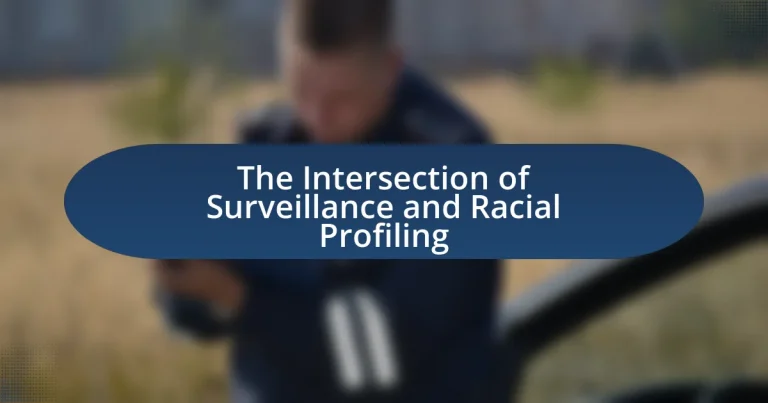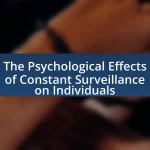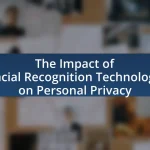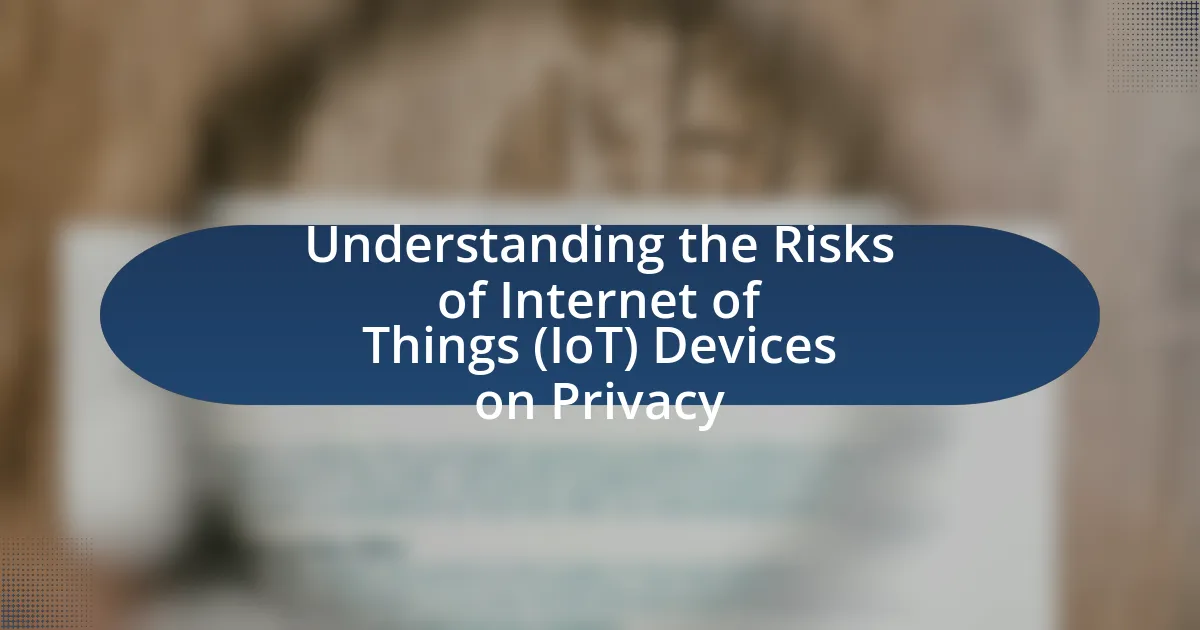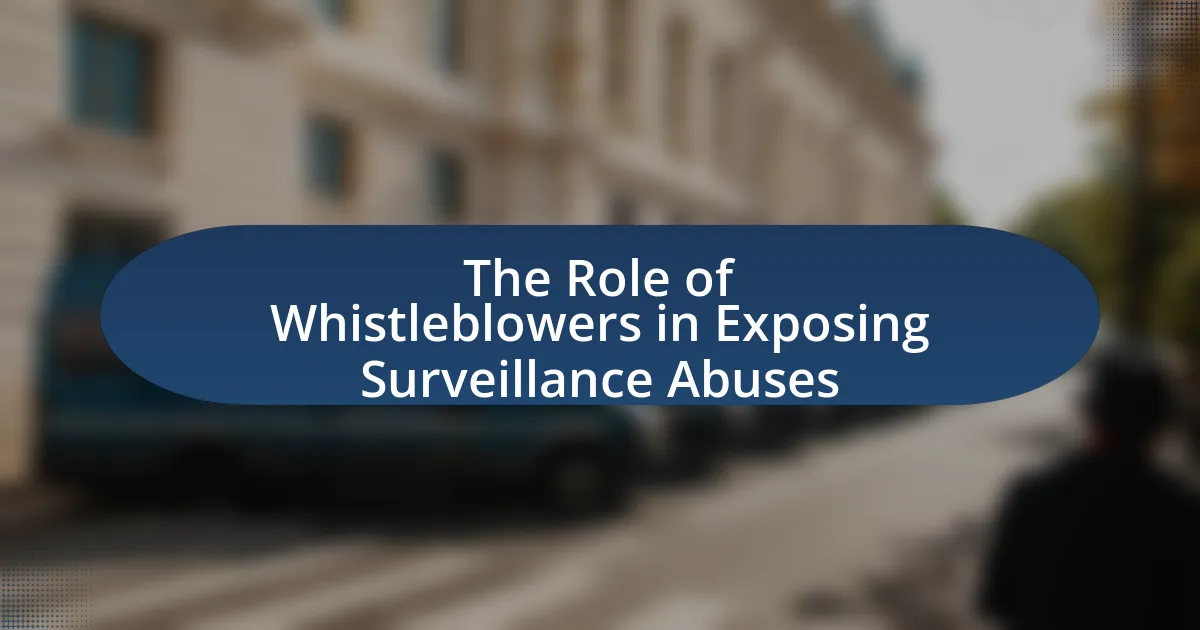The article examines the intersection of surveillance and racial profiling, highlighting how law enforcement disproportionately targets specific racial and ethnic groups through surveillance technologies. It discusses the systemic biases that lead to increased scrutiny of communities of color, the historical context of these practices, and their implications for civil liberties and human rights. The article also explores the psychological effects on targeted communities, the role of public perception, and the effectiveness of existing legal frameworks in preventing racial profiling. Additionally, it outlines strategies for mitigating the negative impacts of surveillance, emphasizing the importance of community engagement and policy reform in promoting accountability and equity in law enforcement practices.
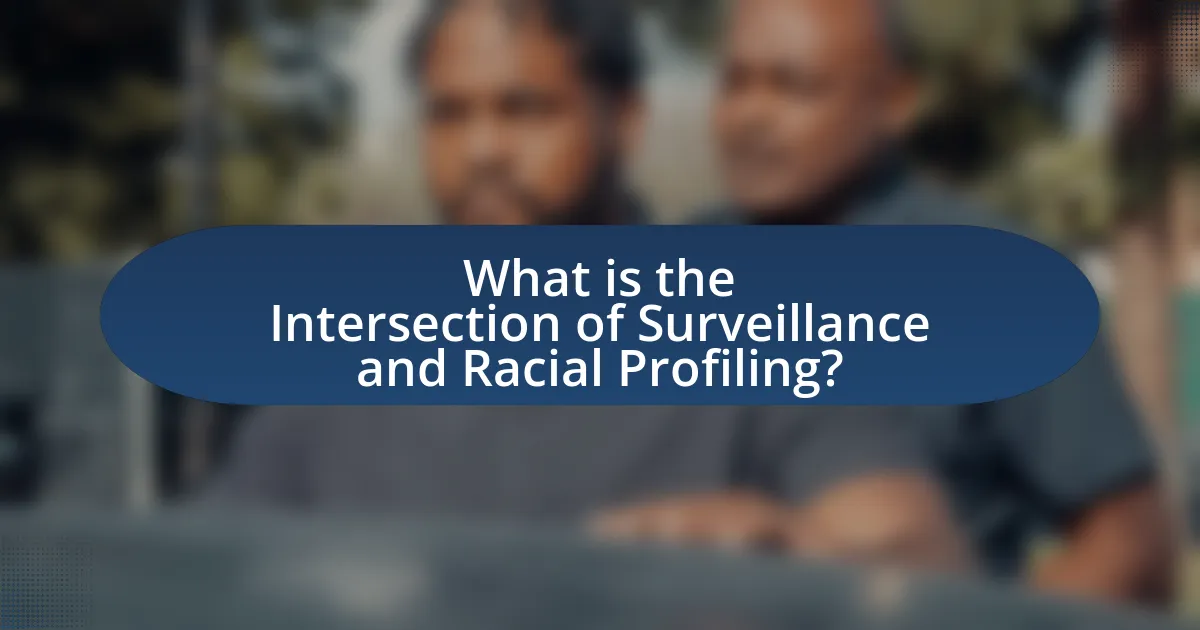
What is the Intersection of Surveillance and Racial Profiling?
The intersection of surveillance and racial profiling occurs when law enforcement and governmental agencies use surveillance technologies disproportionately against specific racial or ethnic groups, leading to biased policing practices. This relationship is evidenced by studies showing that communities of color are often subjected to higher levels of surveillance, such as increased monitoring through cameras and data collection, compared to their white counterparts. For instance, a report by the American Civil Liberties Union (ACLU) highlights that Black individuals are more likely to be stopped and searched by police, which correlates with the use of surveillance technologies that target these communities. This systemic bias raises concerns about civil liberties and the effectiveness of policing strategies.
How do surveillance practices contribute to racial profiling?
Surveillance practices contribute to racial profiling by disproportionately targeting specific racial and ethnic groups based on biased assumptions. For instance, data from the American Civil Liberties Union indicates that law enforcement agencies often utilize surveillance technologies, such as facial recognition, which have been shown to misidentify individuals from minority backgrounds at higher rates than those from majority groups. This misidentification reinforces stereotypes and leads to increased scrutiny and policing of these communities, perpetuating a cycle of discrimination. Furthermore, studies have demonstrated that surveillance systems are frequently deployed in neighborhoods predominantly inhabited by people of color, further entrenching racial biases in law enforcement practices.
What are the historical contexts of surveillance and racial profiling?
The historical contexts of surveillance and racial profiling are rooted in systemic racism and social control mechanisms used by governments and institutions. Surveillance practices have evolved from early forms of policing and monitoring marginalized communities, particularly during the colonial era, where indigenous populations were often subjected to invasive oversight. In the United States, the post-9/11 era saw an increase in surveillance targeting Muslim communities, justified by national security concerns, which echoed earlier practices of racial profiling against African Americans during the Civil Rights Movement. The FBI’s COINTELPRO program, active from the 1950s to the 1970s, exemplified state-sponsored surveillance aimed at civil rights activists, further intertwining racial profiling with law enforcement practices. These historical instances illustrate how surveillance has been employed as a tool for racial discrimination and social control, reinforcing existing power dynamics.
How do different communities experience surveillance differently?
Different communities experience surveillance differently based on factors such as socioeconomic status, racial identity, and geographic location. For instance, marginalized communities, particularly those with higher populations of people of color, often face increased surveillance through police presence, facial recognition technology, and community monitoring initiatives. Research by the American Civil Liberties Union indicates that Black and Latino individuals are disproportionately targeted by law enforcement surveillance practices, leading to heightened feelings of mistrust and fear within these communities. Conversely, affluent neighborhoods may experience surveillance in the form of private security measures that are perceived as protective rather than invasive. This disparity highlights how systemic inequalities shape the nature and impact of surveillance across different communities.
Why is the intersection of surveillance and racial profiling a critical issue?
The intersection of surveillance and racial profiling is a critical issue because it exacerbates systemic discrimination and undermines civil liberties. Surveillance technologies, often deployed in communities of color, disproportionately target these populations, leading to increased scrutiny and unjust treatment. For instance, a report by the American Civil Liberties Union (ACLU) highlights that Black individuals are more likely to be surveilled and subjected to police stops compared to their white counterparts, reflecting a pattern of racial bias. This intersection not only perpetuates stereotypes but also contributes to a cycle of mistrust between law enforcement and marginalized communities, ultimately hindering social cohesion and justice.
What are the implications for civil liberties and human rights?
The implications for civil liberties and human rights in the context of surveillance and racial profiling include increased violations of privacy, discrimination, and erosion of trust in law enforcement. Surveillance practices often disproportionately target marginalized communities, leading to systemic discrimination and a chilling effect on free expression. For instance, studies have shown that racial profiling in policing can result in higher rates of stops and searches for individuals from minority backgrounds, undermining their rights to equal treatment under the law. Furthermore, the use of surveillance technologies, such as facial recognition, has been criticized for its inaccuracies, particularly concerning people of color, which can exacerbate existing inequalities and lead to wrongful accusations. These practices not only infringe on individual rights but also contribute to a broader societal atmosphere of fear and mistrust, ultimately threatening the foundational principles of democracy and human rights.
How does public perception influence the practices of surveillance and profiling?
Public perception significantly influences the practices of surveillance and profiling by shaping the policies and methods employed by law enforcement and governmental agencies. When the public expresses heightened concern about crime or security threats, authorities often respond by increasing surveillance measures and profiling specific demographic groups perceived as more likely to engage in criminal behavior. For instance, following events such as terrorist attacks, public fear can lead to the implementation of more invasive surveillance technologies and practices targeting specific communities, often based on racial or ethnic characteristics. Research by the American Civil Liberties Union highlights that public support for surveillance often correlates with perceived threats, leading to policies that disproportionately affect marginalized groups. This dynamic illustrates how societal attitudes can directly impact the scope and nature of surveillance and profiling practices.
What are the key concepts related to surveillance and racial profiling?
Key concepts related to surveillance and racial profiling include systemic bias, data collection practices, and the impact of technology on policing. Systemic bias refers to the ingrained prejudices within law enforcement that disproportionately target racial minorities, leading to higher rates of surveillance and profiling. Data collection practices involve the gathering of personal information, often without consent, which can perpetuate stereotypes and reinforce discriminatory practices. The impact of technology, such as facial recognition and predictive policing algorithms, raises concerns about accuracy and fairness, as studies show these technologies can misidentify individuals from marginalized communities at higher rates. These concepts highlight the complex relationship between surveillance and racial profiling, emphasizing the need for accountability and reform in law enforcement practices.
What types of surveillance technologies are commonly used?
Commonly used surveillance technologies include closed-circuit television (CCTV), drones, facial recognition systems, license plate readers, and social media monitoring tools. CCTV systems are widely deployed in public spaces for real-time monitoring and crime deterrence. Drones provide aerial surveillance capabilities, often used by law enforcement for crowd monitoring and reconnaissance. Facial recognition technology analyzes facial features to identify individuals, increasingly utilized in security and law enforcement contexts. License plate readers automatically capture and analyze vehicle registration plates, aiding in tracking and identifying vehicles of interest. Social media monitoring tools analyze online activity to gather intelligence on individuals or groups, often used in investigations. These technologies have raised concerns regarding privacy and racial profiling, as their implementation can disproportionately affect marginalized communities.
How does data collection play a role in racial profiling?
Data collection significantly contributes to racial profiling by providing law enforcement with biased information that can reinforce stereotypes. When data is collected primarily from certain racial or ethnic groups, it can create a misleading narrative that these groups are more likely to engage in criminal behavior. For instance, studies have shown that police data often reflects higher arrest rates among minority communities, which can be attributed to increased surveillance and policing in those areas rather than actual crime rates. This selective data collection perpetuates a cycle of profiling, as officers may rely on these statistics to justify stops and searches, further entrenching systemic biases.
How does the legal framework address the intersection of surveillance and racial profiling?
The legal framework addresses the intersection of surveillance and racial profiling primarily through constitutional protections and statutory regulations that aim to prevent discriminatory practices. The Fourth Amendment of the U.S. Constitution protects individuals from unreasonable searches and seizures, which is relevant in cases where surveillance may disproportionately target racial or ethnic minorities. Additionally, laws such as the Civil Rights Act prohibit discrimination based on race, color, or national origin, thereby providing a basis for challenging racially biased surveillance practices. Courts have ruled in various cases, such as Whren v. United States, that racial profiling violates equal protection principles, reinforcing the need for law enforcement to apply surveillance techniques without bias. These legal standards collectively work to mitigate the risks of racial profiling in surveillance activities.
What laws exist to regulate surveillance practices?
Various laws exist to regulate surveillance practices, including the Fourth Amendment of the U.S. Constitution, which protects against unreasonable searches and seizures, and the Electronic Communications Privacy Act (ECPA) of 1986, which governs the interception of electronic communications. Additionally, the Foreign Intelligence Surveillance Act (FISA) regulates government surveillance for national security purposes, while state laws, such as California’s Electronic Communications Privacy Act (CalECPA), provide further protections for individuals’ privacy. These laws collectively aim to balance the need for security with the protection of individual privacy rights.
How effective are these laws in preventing racial profiling?
Laws aimed at preventing racial profiling have shown mixed effectiveness. While some legislation, such as the End Racial Profiling Act, seeks to prohibit discriminatory practices, studies indicate that enforcement and compliance vary significantly across jurisdictions. For instance, a 2013 report by the American Civil Liberties Union found that despite existing laws, racial profiling persists, particularly in law enforcement practices, suggesting that legal frameworks alone may not be sufficient to eliminate the issue. Additionally, a 2020 study published in the Journal of Criminal Justice highlighted that without robust training and accountability measures, the impact of these laws remains limited, as officers may continue to rely on biased assumptions.
What are the societal impacts of surveillance and racial profiling?
Surveillance and racial profiling significantly contribute to societal division and distrust among communities. These practices often lead to the stigmatization of specific racial and ethnic groups, fostering an environment of fear and alienation. For instance, studies have shown that communities subjected to heightened surveillance experience increased anxiety and a sense of vulnerability, which can hinder social cohesion. Additionally, racial profiling can result in disproportionate policing and legal repercussions for minority groups, perpetuating systemic inequalities. According to a report by the American Civil Liberties Union, racial profiling not only undermines public trust in law enforcement but also exacerbates existing social tensions, leading to broader societal implications such as civil unrest and decreased community engagement.
How do these practices affect community trust in law enforcement?
Surveillance and racial profiling practices significantly erode community trust in law enforcement. When communities perceive that law enforcement disproportionately targets specific racial or ethnic groups, it fosters feelings of alienation and distrust. Research by the American Psychological Association indicates that such practices can lead to a breakdown in communication between law enforcement and the communities they serve, as individuals may feel unfairly scrutinized or criminalized based on their identity rather than their behavior. This perception of bias undermines the legitimacy of law enforcement, making community members less likely to cooperate with police, report crimes, or seek assistance, ultimately compromising public safety and community cohesion.
What are the psychological effects on targeted communities?
Targeted communities experience significant psychological effects, including heightened anxiety, stress, and feelings of vulnerability. Research indicates that individuals in these communities often report increased levels of paranoia and mistrust towards authorities, stemming from the constant surveillance and profiling they endure. A study published in the American Journal of Public Health found that racial profiling can lead to chronic stress, which negatively impacts mental health and overall well-being. Furthermore, the stigma associated with being surveilled can result in social withdrawal and a diminished sense of community belonging, exacerbating feelings of isolation and hopelessness.
What strategies can be implemented to mitigate the negative effects of surveillance and racial profiling?
Implementing community oversight and transparency measures can effectively mitigate the negative effects of surveillance and racial profiling. Establishing independent review boards allows community members to monitor law enforcement practices, ensuring accountability and reducing biased profiling. Research indicates that cities with such oversight mechanisms report lower instances of racial profiling, as seen in the 2016 study by the Center for Policing Equity, which found that police departments with community engagement initiatives experienced a decrease in complaints related to racial bias. Additionally, training programs focused on implicit bias for law enforcement personnel can further reduce discriminatory practices, as evidenced by a 2018 report from the National Institute of Justice, which highlighted the effectiveness of bias training in improving officer interactions with diverse communities.
How can community engagement improve accountability in surveillance practices?
Community engagement can improve accountability in surveillance practices by fostering transparency and enabling public oversight. When communities actively participate in discussions about surveillance policies, they can voice concerns, influence decision-making, and hold authorities accountable for their actions. For instance, research from the American Civil Liberties Union highlights that cities with community advisory boards on surveillance technologies report higher levels of public trust and accountability, as these boards facilitate dialogue between law enforcement and community members. This engagement leads to more equitable surveillance practices that consider the community’s needs and rights, ultimately reducing the potential for racial profiling and misuse of surveillance data.
What role does policy reform play in addressing these issues?
Policy reform plays a crucial role in addressing the issues of surveillance and racial profiling by establishing legal frameworks that protect marginalized communities from discriminatory practices. Effective policy reform can lead to the implementation of regulations that limit the use of surveillance technologies, ensuring they are not disproportionately applied to specific racial or ethnic groups. For instance, the introduction of laws that mandate transparency in surveillance practices can help hold law enforcement accountable, thereby reducing instances of racial profiling. Studies have shown that jurisdictions with comprehensive oversight mechanisms experience fewer complaints related to racial discrimination in policing, highlighting the positive impact of policy reform on community trust and safety.
What are best practices for addressing the intersection of surveillance and racial profiling?
Best practices for addressing the intersection of surveillance and racial profiling include implementing transparent policies, ensuring community engagement, and utilizing data-driven approaches. Transparent policies establish clear guidelines on surveillance practices, which can help mitigate biases and protect civil liberties. Community engagement fosters trust and allows for input from affected populations, ensuring that surveillance measures are equitable and just. Data-driven approaches, such as regular audits and assessments of surveillance data, can identify patterns of racial profiling and inform necessary adjustments to policies. Research indicates that jurisdictions employing these practices have seen reductions in racial disparities in policing outcomes, demonstrating their effectiveness in promoting fairness and accountability.
